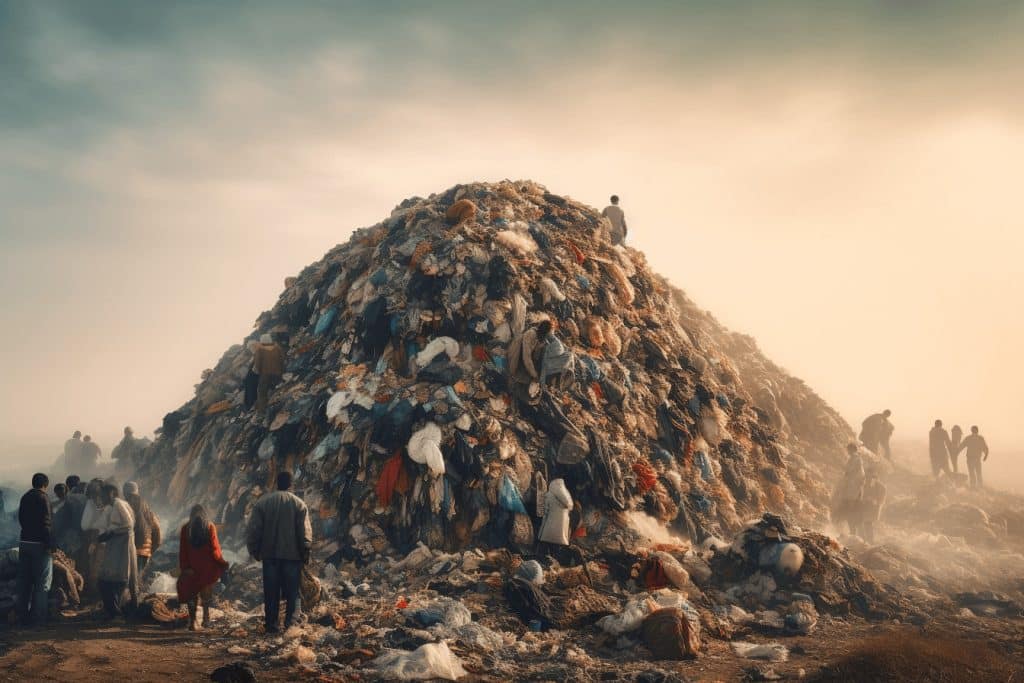Fast fashion offers trendy clothing at low prices, but its environmental impact is significant. This article delves into how the fast fashion industry contributes to environmental degradation and explores emerging trends aimed at mitigating these effects.

The Environmental Impact of Fast Fashion
Water Consumption and Pollution
The fashion industry is the second-largest consumer of water globally. Producing a single cotton shirt requires approximately 700 gallons of water, while a pair of jeans can consume up to 2,000 gallons . Additionally, textile dyeing processes contribute to about 20% of global clean water pollution .Geneva Environment Network+1Earth.Org+1Earth.OrgEuropean Parliament
Carbon Emissions
Fast fashion is responsible for about 10% of global carbon dioxide emissions, surpassing the emissions from international flights and maritime shipping combined . The industry’s reliance on synthetic fibers, which are energy-intensive to produce, exacerbates its carbon footprint.Wikipedia+2UniformMarket+2Earth.Org+2The National Wildlife Federation Blog+1UniformMarket+1
Textile Waste
The rapid turnover of fashion trends leads to significant textile waste. Approximately 85% of all textiles end up in landfills each year . In the U.S., the average person discards about 70 pounds of clothing annually .Geneva Environment Network
Microplastic Pollution
Synthetic fabrics like polyester shed microplastics during washing. A single laundry load can release up to 700,000 microplastic fibers, which often end up in oceans, harming marine life .European Parliament+2Wikipedia+2Young Eden+2European Parliament
Emerging Trends Addressing Fast Fashion’s Impact
Circular Fashion Initiatives
The concept of circular fashion focuses on designing products for longevity, reuse, and recyclability. The European Union has adopted strategies to promote sustainable and circular textiles, aiming to minimize waste and maximize resource efficiency .Wikipedia+3Mintel+3Vogue Business+3
Rise of Secondhand Clothing
Economic pressures and environmental awareness have led to a surge in the secondhand clothing market. Platforms like ThredUp and Goodwill have seen increased popularity, with projections estimating the U.S. secondhand market to reach $73 billion by 2028 .Business Insider
Technological Innovations
Advancements in recycling technologies, such as chemical recycling, allow for the breakdown and reuse of synthetic fibers. Companies are investing in these technologies to reduce textile waste and reliance on virgin materials .
Consumer Actions to Mitigate Impact
- Buy Less, Choose Wisely: Opt for quality over quantity. Investing in durable clothing reduces the frequency of purchases.
- Support Sustainable Brands: Patronize companies that prioritize ethical labor practices and environmentally friendly materials.
- Embrace Secondhand Shopping: Thrift stores and online resale platforms offer fashionable options without the environmental cost.
- Proper Clothing Care: Washing clothes in cold water and air-drying can extend their lifespan and reduce energy consumption.
Conclusion
While fast fashion provides affordable clothing options, its environmental repercussions are profound. By embracing sustainable practices and supporting circular fashion initiatives, both consumers and the industry can work towards a more environmentally responsible future.
References:
- Earth.Org. (2025). Fast Fashion and Its Environmental Impact in 2025. Retrieved from https://earth.org/fast-fashions-detrimental-effect-on-the-environment/Earth.Org+2Earth.Org+2Carbon Trail+2
- European Parliament. (2023). The impact of textile production and waste on the environment. Retrieved from https://www.europarl.europa.eu/topics/en/article/20201208STO93327/the-impact-of-textile-production-and-waste-on-the-environment-infographicsEU Reporter+2European Parliament+2European Parliament+2
- UniformMarket. (2025). Fast Fashion Statistics 2025. Retrieved from https://www.uniformmarket.com/statistics/fast-fashion-statisticsUniformMarket
- Geneva Environment Network. (2025). Environmental Sustainability in the Fashion Industry. Retrieved from https://www.genevaenvironmentnetwork.org/resources/updates/sustainable-fashion/Geneva Environment Network
- Vogue Business. (2025). Can the UK become a global leader in circular textiles? Retrieved from https://www.voguebusiness.com/story/sustainability/can-the-uk-become-a-global-leader-in-circular-textilesVogue Business+2Vogue Business+2Vogue Business+2
- Business Insider. (2025). Secondhand clothing is in fashion — and Trump’s tariffs are helping. Retrieved from https://www.businessinsider.com/trumps-tariffs-secondhand-clothing-industry-thrift-charity-stores-goodwill-thredup-2025-5Business Insider
- Wikipedia. (2025). Fast fashion. Retrieved from https://en.wikipedia.org/wiki/Fast_fashionWikipedia









